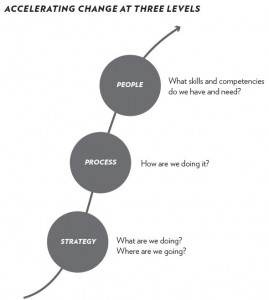
Selecting the right MSP program is no simple task. Recently, we participated in an interesting debate that illustrated the many nuances of MSP/VMS programs. What emerged was a topic that sometimes gets lost in the shuffle of business — that an intermediated workforce solution isn’t always a silver bullet. Of course, the secret here is being selective. Not all programs are created equally. Clients and suppliers must vet their prospective MSPs to determine integrity, level of support, fit and real opportunity. No single management model is a panacea for every client, industry or program. Based on our successes with MSPs and the input of industry experts from both sides of the issue, here are some key considerations to keep in mind when deciding whether a managed services program is right for you.
Industry Fit
MSPs come in different flavors. There are boutique providers that cater to specific industries and niches. There are large MSPs that deliver comprehensive support, yet specialize in particular industry segments and job categories. Then there are those firms that position themselves as universal one-stop-shops for every client, every role. There’s something to be said about the first two scenarios. In business, a great deal of success has been generated by companies that focus on their core capabilities and consistently deliver superior results. And in some cases, organizations that take on too much — or attempt to be all things to all people — run the risk of diluting their offerings.
From what we’ve seen in staffing publications and studies, it’s clear that not every industry has achieved its desired outcomes by using external providers. Others have enjoyed amazing performance. In the utilities sector, for example, MSPs have proven reliable and effective. Consider the example Phillips 66 offered to Staffing Industry Analysts (SIA). Their invoice error rate went from 8.5% to 0%. Prior to the program, it had been greater than 20%. Their supplier compliance improved from 37% to 97%. Phillips 66 also saw rate management improve by 62%, and they realized cost savings and avoidance of 20% during the reporting period for the case study.
Other companies and industries report similarly compelling results. However, that’s not to say success is universal. Clients in the healthcare sector, particularly those with smaller programs, consistently cite challenges with their experiences. A lot of these organizations have managed to prove that their internal teams are more efficient and cost effective than a third party solution.
Healthcare firms represent around 7% of MSP/contract labor spend in the United States. Despite being a trillion-dollar industry, less than 5% of staffing at hospitals is filled by contingent talent. The highly skilled nature of workers, the intricacies of the industry and complex compliance issues bring further challenges. Adoption for the MSP model in the health services space is beginning to grow, in part because of specialty MSPs such as AMN Healthcare.
In an article for Modern Healthcare, Dr. Gerald Wydro of Aria Health system praised the results of turning to an MSP. “If we would have used five locums companies, we would have failed at this,” he explained. “We also would have failed without on-site MSP leadership.” That said, Dr. Wydro also admitted that using an MSP was more expensive.
Understand Hard and Soft Cost Savings
In the examples above, we saw how two different industries responded to an MSP program. For the utilities firm, a large MSP with broad services performed well. The client had the volumes, decentralization, vast supplier base and lack of spend consolidation to justify the model. In healthcare, success required a specialized MSP, and the client was willing to sacrifice savings in favor of operational efficiencies. That brings us to the issue of dollars and cents.
Cost containment is one of the biggest selling points for MSPs. In the first year of the program, cost savings are measurable. Afterward, the best MSPs switch to a more strategic initiative to increase quality, performance, continuous improvement, the client’s competitive edge and more. Some clients view this switch as the MSP’s inability to maintain cost savings. In many ways, it’s not the case.
There are programs that have exaggerated their cost containment abilities or missed targets. There are also others that achieve amazing results. In some instances, issues arise because client stakeholders disengage themselves from the program, making it difficult for MSPs to perform. Some clients also ignore the soft cost savings brought by an MSP, and focus only on hard dollars. Research has shown that these soft costs are impactful.
- Reining in maverick spend can lead to savings of 3.5%.
- Invoice accuracy can generate up to 1% savings.
- Job classification precision can also yield 1% savings.
- Process improvements have been found to drive savings of up to 15%.
- Monitoring supplier performance can lead to 2% savings.
- Centralized program management can also achieve 2% savings.
For the right client and program model, MSPs provide a team of qualified professionals at a price that saves money in the long term. Even without an MSP, many internally run programs encounter the same obstacles. When companies set a threshold predicated on below-market rates, procurement officers and hiring managers find themselves in an untenable situation. While suppliers won’t necessarily disengage from the project, they will lean toward filling only those positions where the margins are appropriate and sustainable.
Our MSP partners work with market-based rates, provide a level playing field through vendor neutrality, negotiate competitive markups, and everybody wins. This is something clients and suppliers should evaluate in their potential MSP partners. Here are some other suggestions.
- Make sure the MSP provides a cost savings plan that’s realistic and attainable. Some clients have pie-in-the-sky expectations of savings, and some MSPs simply agree to deliver. The best programs are transparent and collaborative. If an MSP works with you to create a savings plan you both can commit to — even if that means pushing back a little — then you’ve found a partner who will deliver.
- Make sure the MSP explains soft cost savings and benefits. As we saw with Aria Health, the value of soft costs may outweigh the perceived benefit of hard dollar savings.
Succession Planning
One of the most crucial points raised in the debate about external vs. internal models involved the idea of succession planning. If your relationship with an MSP has soured, bringing aboard a new firm can be a painful and cumbersome process. Removing a problematic, enterprise-wide solution is no easy task. Look at some of the horror stories associated with SAP. It’s one of the world’s most popular enterprise resource platforms (ERPs). For the right clients, it’s the cure to countless woes. However, when improperly fit to a business, SAP implementations become unwieldy monsters. They can take years to deploy. Once embedded, they’re virtually impossible to remove.
Look for MSPs that have incorporated a clear exit strategy into their contractual obligations. We’ve met MSPs who do this regularly. They have a process to ensure vendor payments, and they work closely with the new service provider to transition workers, suppliers, program data, and processes into the new program to prevent business disruption. This kind of succession planning is the hallmark of true professionals.
The Right of Range of Services
Some companies rely on a variety of outsourced service providers to meet their workforce goals: one for staffing, one for payrolling, one for project-based contracting and so forth. Others need only a few core services. The traditional thinking is that clients should find a large MSP that can support every solution as a single source. However, that approach may not fit every business. To ensure optimal program management and value, evaluate several MSPs. Find those providers that offer the precise range of services you need now or anticipate utilizing in the near future.
The truth is that there is no one-size-fits-all miracle awaiting clients. The most credible, customer-centric MSPs are those with reputations for tailoring their solutions to each client. Every organization, workforce and situation is unique. The right MSP analyzes your company, assesses your contingent labor requirements and makes recommendations for a customized program.
MSP Program and Industry Expertise
Elite MSPs staff their own organizations with experts. They don’t just understand the job of an MSP, they understand the industry, labor regulations, employment policies, supply chain management, business development and more. Beyond outsourced management for vendors and contingent talent, a great MSP should serve as a sort of workforce consultant. Ask your prospective service provider to give you an overview of the team and each member’s credentials — not just their responsibilities. Some of the qualities you’ll want to uncover include:
- Experience in staffing and recruiting
- Experience in managed services (as a manager or even a participant)
- Strong customer-service experience in front line support
- Corporate backend support teams with expertise in finance, billing, compliance, risk and legal
- Strong technology skills, both utilizing and supporting users
- Data analysts skilled in monitoring and reporting on KPIs, SLAs, costs and other metrics
Strategic Partners
As a staffing provider, we set out to work with MSPs. That probably sounds like a rare thing. Yet it doesn’t mean we haven’t been just as selective as clients in choosing our MSP partners. The result? Our experience has been incredibly positive. Our MSP champions support us, endorse us and give us access to a spectrum of opportunities we may not have had.
As your workforce program matures, you need a business partner — not just a vendor. The MSP that’s right for you is an ally to your team and supplier population. These firms offer libraries of best practices, regulatory knowledge, lessons learned, risk avoidance, competitive growth strategies and innovations gleaned from experiences at other engagements. Their role is to help you focus on reaching your business goals while optimizing your talent and supplier processes. Most MSPs can deliver cost savings — the real treasure is found in a partner that evolves alongside your program, priorities, mission and business objectives.
Business & Finance Articles on Business 2 Community(29)






